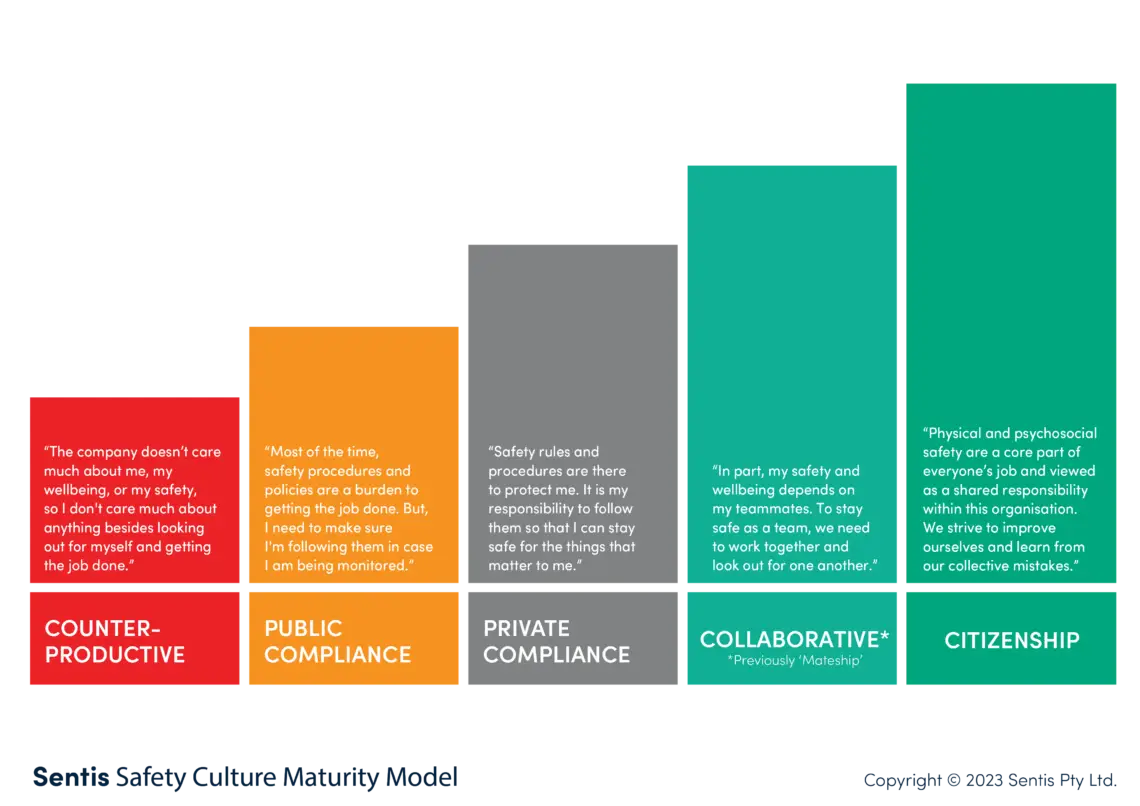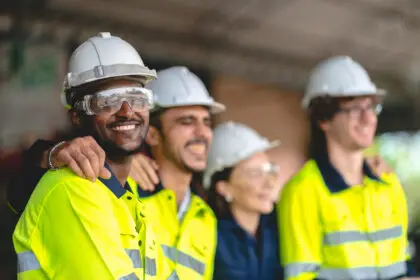When seeking to drive safety performance improvement, we often look to previous incidents to see how we can prevent them from reoccurring in the future. But while this is a necessary step in the right direction, if our focus is only based on avoiding mistakes, instead of also actively aspiring towards excellence, we risk a plateau in cultural growth.
If we want to take a more holistic approach, where do we start? Just like incidents can leave clues about how to prevent them in the future, analysing the success of organisations with mature safety cultures can provide us with unique insights that we can leverage to accelerate our cultural maturity. And there’s a strong case that this improvement is not only desirable, but desperately needed.
Our recent study spanning 73 organisational sites and eight industries found that an alarming 86% of organisational sites operate within a negative safety culture—or a culture that is driven by shared safety attitudes and beliefs that are unhelpful and/or counterproductive to safe work.

Safety culture maturity is a spectrum and when it comes to maturity levels, we classify negative safety cultures as those sitting at either Counterproductive or Public Compliance. In these types of cultures, and for the 86% of organisational sites that operate within them, the risk of incident and injury is high.
But what about the other 14% that sit within a positive safety culture—where shared safety attitudes and beliefs are helpful? What is it about these sites that has allowed them to thrive when it comes to safety?
Before we jump into the top five lessons, let’s take a quick moment to discuss the key tipping point for a negative safety culture to progress to a positive one.
Private Compliance safety culture – the tipping point towards safety excellence
Unlike in negative safety cultures where safety is seen as merely a compliance requirement or something to get the boss off your back, workers in Private Compliance safety cultures take personal ownership over their safety. They genuinely see the value in demonstrating safe behaviours, and in turn, they adhere to safety procedures and protocols regardless of supervision. Simply put, they comply with their safety responsibilities because they want to—not because they have to.
This sense of personal ownership and accountability for safety is a core building block for a positive safety culture, because it drives an internal motivation for staying safe—instead of relying on external factors such as a fear of negative repercussions or constant supervision from management. It involves a shift in perceptions. Safety goes from being perceived as a time, effort or production cost to being perceived as a currency that helps to ensure they return home to the people and things they value most. It shifts the perception of safety procedures from being an inconvenience to being helpful tools that support this goal.
So, if the first step on the journey towards safety excellence is to work towards Private Compliance, what can we learn from those that are already there? And further, what can we learn from those that sit at the even more mature level of Collaborative?
Our recent study compared the characteristics of sites with negative safety cultures (Counterproductive and Public Compliance), with organisations that have excelled and operate within positive safety cultures (Private Compliance and Collaborative). This allowed us to identify the five most important factors that have enabled the sites with positive safety cultures to thrive.
Lessons from sites doing well
Top five strength areas identified across sites operating at Private Compliance and Mateship levels of safety culture.

*Denotes dimensions that have a strong correlation with safety culture maturity (Pearson correlation ≥0.70)
1. Safety mission & vision
“Safety is our number one value and most people would know that.”
A safety mission and vision sets the standard for safety excellence by giving people a common goal to work towards. It also drives their choices and behaviours in the day-to-day activities that they undertake. More importantly, a strong safety mission and vision continues to motivate workers even when they aren’t being supervised.
When considering safety mission and vision, we look to determine:
- how aware employees are of their organisation’s safety vision and values
- how well they are actively integrating it into their daily activities
- whether or not workers can describe a clear vision for safety.
Tip for Leaders
To reinforce your safety mission and vision, start by ensuring that you have a clear safety vision in place that’s easily understood and communicated throughout every level of your organisation. Also ensure that your vision not only addresses the ‘what’ and the ‘how’ of safety, but that it also makes a clear and compelling argument for ‘why’ it’s important. This is key to increasing commitment and buy-in from your team to accomplish it.
2. Management safety commitment
“Safety, then schedule, then cost.”
Also identified as a top strength for sites with positive safety cultures, it comes as no surprise that management safety commitment is listed as a top strength for sites with exceptional safety cultures. Referring to workers’ perceptions of how highly management prioritise safety, workers in sites with Private Compliance and Mateship cultures felt that management didn’t just talk the talk—but they also walked the walk.
By actively prioritising safety over production and spending adequate time on site, management showcased a genuine commitment to safety that reinforced the behaviours they expected from their teams. Be it through easy access to budget to purchase necessary safety equipment or by implementing strategies to ensure safe work, they reinforced that safety comes first. In doing so, their workers then followed suit by also making safety a priority—leading to substantially improved safety performance.
Tip for leaders
To take the first steps towards truly showing your commitment to safety, start by spending more time on site with your workers talking about health and safety. Then, review any incentives tied to safety and production performance and consider what messages they might be sending to the workforce. Are these incentives unintentionally prioritising production over safety, or do they promote an environment of safe production? Finally, ensure that your team members have easy access to budgets to purchase necessary equipment and to implement strategies to ensure safe work—showing that you ‘walk the walk’ when it comes to safety.
3. Within-team safety communication
“Everyone talks safety; sometimes we can’t shut them up!”
A reference to the frequency and quality of safety messaging and discussions between teams, within-team safety communication was listed as a key strength for more mature safety cultures.
Within these sites, workers held positive perceptions of safety briefings such as prestarts and toolbox talks, and reported that they occurred frequently with high attendance rates and engaging communication. The biggest factor to this, and a key point-of-difference when comparing to more negative cultures, was the encouragement of two-way communication and worker participation. Rather than running these briefings as lectures or ‘tick and flick’ activities, leaders actively encouraged open discussions about safety hazards, ensuring mutual understanding and high-quality safety communications. They then regularly backed this up with casual safety-related conversations, even when it wasn’t formally required to have them. In doing so, they continued to drive exceptional safety performance by ensuring that safety remained front of mind.
Tip for leaders
As a leader looking to improve your within-team safety communication, start by reviewing your safety briefings for frequency, attendance and quality. Check in with your workers to see if they actually find these to be relevant and useful, or if they’re being perceived as yet another ‘tick and flick’ activity. Then, follow this up by actively encouraging two-way communication during safety briefings and by opening up discussions around safety hazards and controls.
4. Safety responsibility
“Anyone can pipe up and say stop!”
Safety responsibility refers to the level of discretionary effort that workers display when it comes to safety activities, their ownership of their safety duties and the relationships that they have with the health and safety team and other workgroups. Given that it’s one of the most defining factors of a mature safety culture, it’s perhaps the most critical thing that leaders can leverage for safety culture improvements.
Within sites with high levels of safety responsibility, workers perceived safety to be an integral aspect of every individual’s role and took personal responsibility for the safety of themselves and those around them. Crews at all levels showed belief in the importance of maintaining sustained vigilance to both detect and control hazards. Additionally, they were open to feedback regarding their safety performance and when coached on how to make safer choices, received it positively and genuinely appreciated the concern for their safety. They also felt empowered to not only identify and address hazards as they arose, but to also stop work if necessary as they were already given permission to prioritise safety without any fear of negative repercussions. With safety being set as a non-negotiable standard, it led to workers being more willing to participate in safety activities and initiatives set by the health and safety team.
Tip for leaders
To start nurturing a sense of personal responsibility and initiative, put aside time to help your workers understand the importance of safety and exactly how it relates to their personal goals, as well as the goals of their teammates and the organisation. By helping them understand and connect with the ‘why’ behind safety processes and behaviours, and aligning it with a larger vision and goals, individuals are substantially more likely to take personal ownership over their safety.
5. Team support for safety
“There’s a genuine care for each other’s safety.”
Team support for safety helps sets the standard for safety in the workplace and serves as a security net that protects the culture from slipping backwards. When measuring this characteristic of safety culture, we look to:
- the quality of relationships between team members
- the level of care and concern they have for each other
- the willingness to confront a co-worker who violates safety standards.
A key strength for Private Compliance and Mateship
cultures, workers felt like their co-workers genuinely cared for and supported each other. Specifically, they reported looking out for each other, encouraging each other and being willing to help out when it came to keeping each other safe. Instead of viewing safety procedures as just another compliance requirement, they viewed safety as a team effort where all individuals must work together to keep each other safe. A major aspect of this was linked to the organisation’s ability to nurture a sense of psychological safety in their workers. That is, a measure of a worker’s belief that they can freely express their ideas, opinions and concerns without fear of negative repercussions.
By nurturing higher levels of psychological safety through increased care and support for safety within teams, they empowered their workers to speak up for safety whenever necessary, even if it meant immediately stopping work until it was safe to resume.
Tip for leaders
To leverage this opportunity within your organisation, begin by reflecting on the level of psychological safety within your team and the willingness of your workers to speak up for safety. Do they feel empowered to identify and address hazards as they arise, or would they be unwilling to stop work for safety or to provide feedback to peers working unsafely?
With this benchmark in mind, continue to nurture a sense of psychological safety by shifting the focus of incident investigations and potentially difficult conversations away from attributing blame and towards creating a culture of learning and improvement by leveraging them as the learning opportunities that they are. In doing so, you can start giving your people the reassurance that you genuinely care for their safety—even if it stands in the way of production.
Success leaves clues – you just have to follow them
As you can see, while it’s important to evaluate the factors that contribute to negative safety cultures , it’s equally as valuable to look towards organisations that are excelling to identify the most important factors that are driving those positive results.
A good starting point is to consider how your organisation performs on the five key areas discussed above and whether there are any tips and recommendations you can immediately implement. Additionally, a full safety culture diagnostic can identify the unique strengths and opportunities across your organisation and provide specific recommendations tailored to your business.
For additional recommendations and to learn more about the current state of safety culture, download a copy of our latest e-book on Driving a Positive Safety Culture.
Remember, the goal with safety culture development isn’t just to avoid incidents—it’s to actively help your people thrive. There’s no better way of learning how to do that than by learning from organisations that are already achieving it.




